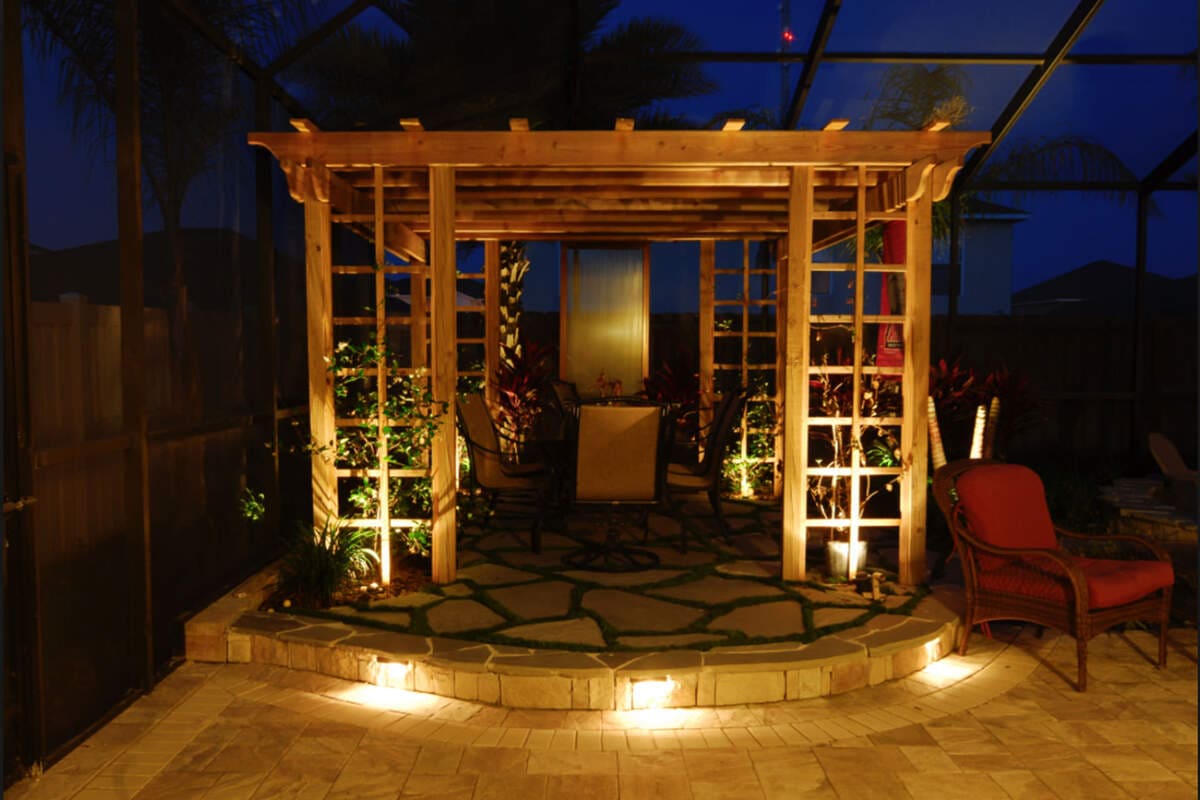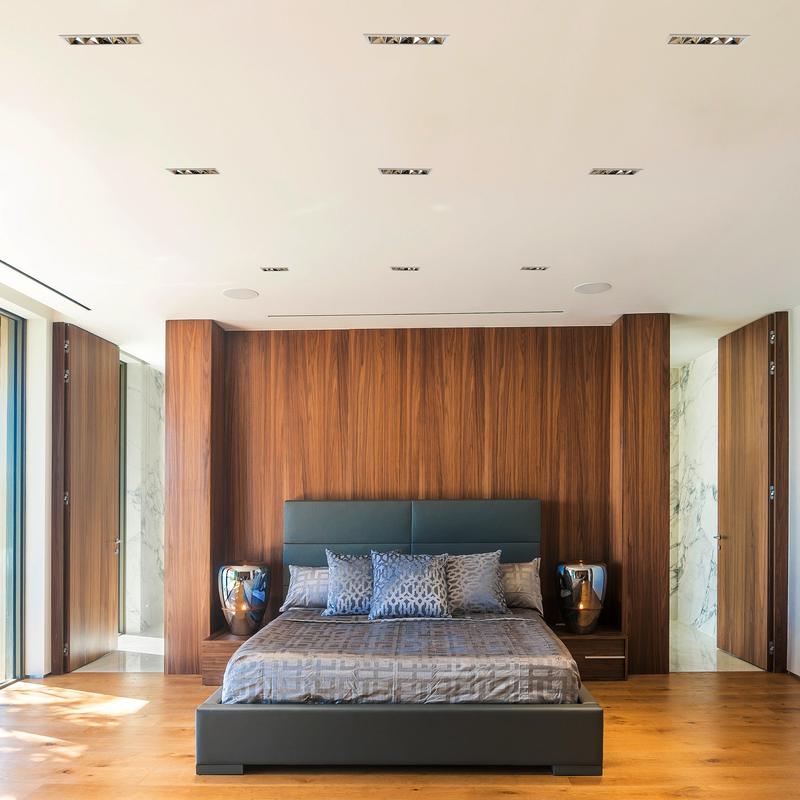Designing an office lighting plan transcends mere calculations and the selection of luminaires. The lighting solution significantly influences the ambiance of the workspace, impacting the psychological well-being, engagement, and enthusiasm of employees. It must elevate the sense of well-being and productivity, necessitating meticulous consideration of the office interior design to foster a stimulating environment. Employees require a setting where they can perform their tasks comfortably and efficiently, in the space where they spend a substantial portion of their lives.
LEDAPLUS will expertly guide you through the lighting process, serving as your premier lighting resource. LEDAPLUS, with its unparalleled expertise, offers a diverse array of lighting systems, including track, recessed, hi-bay, and decorative solutions, ensuring that spaces remain vibrant and contemporary. Ensuring your lighting investment yields tangible returns necessitates time and effort, and we commit to partnering with you at every stage of this journey.
Goals of Commercial Lighting
Lighting stands as one of the most efficacious and straightforward methods to enhance the office environment. The intricate challenge lies in devising a cohesive office lighting plan that adeptly illuminates the diverse spaces coexisting under one roof: reception areas, expansive open office spaces, and private offices of varying dimensions. The lighting must not only represent but also reinforce the corporate image. Compliance with energy codes, concerns regarding energy costs, and the efficiency of the lighting system are paramount, alongside the necessity for flexibility to accommodate the company’s growth and evolving lighting needs.
- Foster a cohesive environment that elevates the well-being and productivity of office staff.
- Develop a versatile lighting plan enabling employees to perform tasks comfortably, effectively, and safely.
- Integrate and harmonize ambient, task, accent, and decorative lighting throughout the office.
- Ensure seamless transitions between different office spaces.
- Design a lighting strategy for long-term employee comfort, balancing energy savings with lighting quality.
- Incorporate and control natural daylight to boost employee morale and reduce energy expenses.
- Address energy efficiency and adherence to energy codes.
The principal function of lighting within office spaces is to facilitate work. It significantly influences the office ambiance and shapes how employees, clients, and customers perceive the company and its image. The impact on the well-being and productivity of the office staff is profound. Consequently, office lighting is a critical element in the successful operation of any business.
When developing a lighting plan, designers must consider a myriad of key characteristics including lamp life, system efficiency, lumen maintenance, color rendering and appearance, daylight integration and control, light distribution, focal points, cost, and system control and flexibility.
Color, Reflection, and Contrast
Light source color properties are defined by two critical measures: Correlated Color Temperature (CCT) and Color Rendering Index (CRI).
Selecting light with the appropriate color temperature and CRI is paramount. Lighting significantly influences the company’s image and the ambiance of the space.
All light sources are not created equal. Two sources of white light may appear identical, yet render colors differently or impart a distinct atmosphere to the space. Utilizing lamps with the same Correlated Color Temperature and similar Color Rendering Indices ensures uniform and consistent illumination throughout the area.
Reflection and glare can be both advantageous and detrimental in office lighting. Well-designed lighting enables clear visibility of tasks and devices but can also create unproductive and harmful conditions.
Employing luminaires with effective glare control prevents direct glare and minimizes disturbing reflections on specular surfaces. A very bright space does not constitute the most efficient lighting solution. Careful selection and strategic placement of fixtures foster a welcoming and productive environment.
Correlated Color Temperature
Correlated Color Temperature (CCT) quantifies a lamp’s color appearance when illuminated. Each lamp is assigned a color temperature based on the hue of the emitted light. White light is categorized into three primary types: warm, neutral, and cool, measured in Kelvin (K).
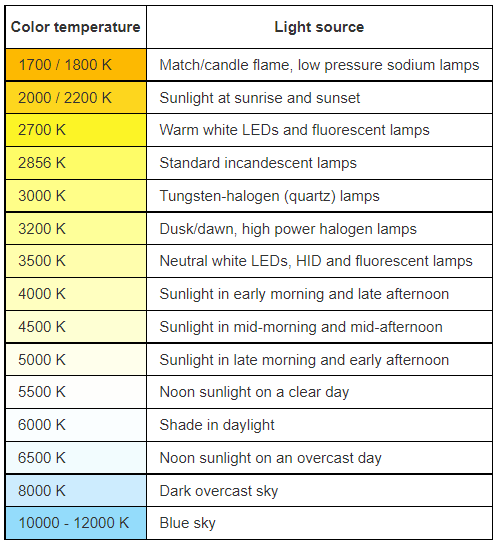
CORRELATED-COLOR-TEMPERATURE
“Warm white,” below 3000K, emits a yellowish hue reminiscent of candlelight. This temperature range accentuates reds and oranges, mutes blues, and introduces a yellow tint to whites and greens. “Neutral white,” ranging from 3000K to 3500K, enhances most colors uniformly without biasing towards yellow or blue. “Cool white,” above 3500K, exudes a bluish tone similar to moonlit snow, enhancing blues, subduing reds, and imparting a bluish cast to whites and greens.
Warm light creates an intimate, cozy, and familiar ambiance, making spaces feel smaller. Conversely, cooler light imparts a sense of openness and expansiveness, making areas appear more spacious.
Color Rendering Index
Color Rendering Index (CRI) quantifies how accurately a light source reveals the colors of objects compared to a reference light source. CRI is instrumental in comparing light sources of the same type and Correlated Color Temperature (CCT).
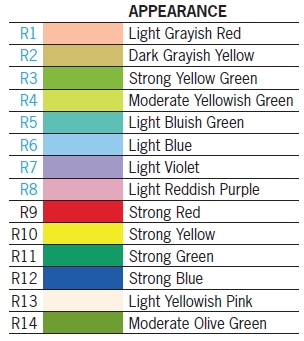
Color Rendering Index Appearance
To determine CRI, a set of specific reference colors is employed. Each R-value represents the difference between the color sample illuminated by the test light source and the reference source. These values are averaged to yield a score between 0 and 100, with 100 indicating the closest match between light sources.
A higher CRI signifies superior color rendering, making colors appear more vivid and natural. For accurate and lifelike color presentation, which enhances visual comfort, a CRI value between 80 and 100 is recommended.

Reflection
Consideration of light reflection off various surfaces within a space is integral to effective lighting design. Utilizing surfaces with higher reflectance increases light reflection back into the area, thereby enhancing illuminance levels.
Light reflectance operates on a scale from 0, indicating total surface light absorption, to 100, signifying total light reflection.
Materials with spread reflection, such as brushed aluminum, exhibit high but diffused reflection, reflecting 5-10% of light. Diffused reflection materials, like a white-painted wall, provide uniform brightness and serve as excellent reflective backgrounds for coves and smaller spaces.
| MATERIAL | REFLECTANCE PERCENT |
|---|---|
| Diffuse: Uniform surface brightness | |
| Limestone | 35-60 |
| White Paint | 75-90 |
| White Structural Glass | 70-80 |
| Spread: General diffuse reflection | |
| Brushed Aluminum | 55-60 |
| Etched Aluminum | 70-82 |
| Processed Aluminum (Diffuse) | 70-80 |
| Satin Chrome | 50-55 |
| Specular: Directional control of brightness at specific angles | |
| Chrome | 60-65 |
| Metal coated plastic | 75-95 |
| Mirrored and optical-coated glass | 80-95 |
| Polished aluminum | 69-70 |
| Stainless Steel | 55-65 |
Contrast Ratios
Merely increasing the brightness in space is neither efficient nor effective; the essential approach lies in layering light and utilizing contrast throughout the environment.
Lighting design comprises four fundamental layers: general lighting (ambient), accent lighting, task lighting, and decorative lighting. Measured in footcandles, the Illuminating Engineering Society of North America (IESNA) provides illuminance-level recommendations based on the type of lighting, the specific space, the intended user, and the lighting’s purpose. By layering these various light types, depth and dimension are introduced to the space.
Contrast is achieved by enhancing illumination within specific lighting types, particularly task and accent lighting, to emphasize objects against the general light levels. Contrast serves to create visual hierarchies within the environment. For instance, a 2:1 contrast ratio, where accent lighting is twice as bright as general lighting, results in a subtle contrast. Conversely, a 30:1 contrast ratio produces a pronounced focal effect on highlighted items.
Each lighting type offers numerous options. By integrating the recommended light levels and contrast ratios, the final outcome is a space characterized by high visual interest, depth, and dimension.
Layers of Commercial Light
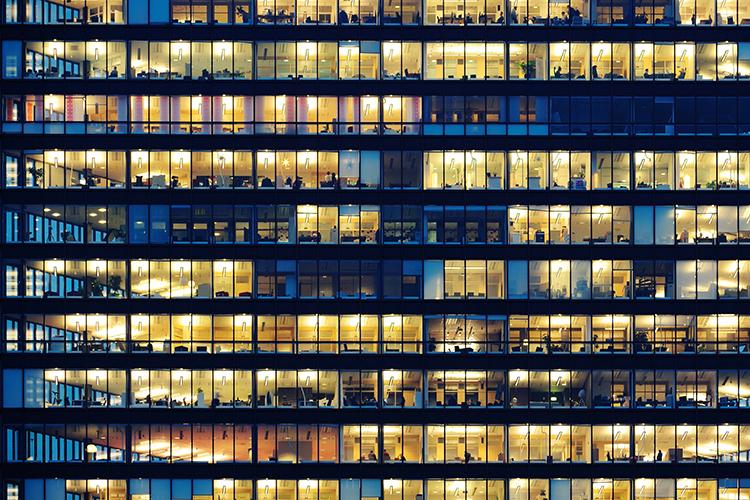
Commercial lighting typically encompasses four essential layers: general (ambient) lighting, task lighting, accent lighting, and decorative lighting. Skillfully combining and balancing these layers imbues a space with visual interest, creating a more engaging and inviting environment.
General Lighting
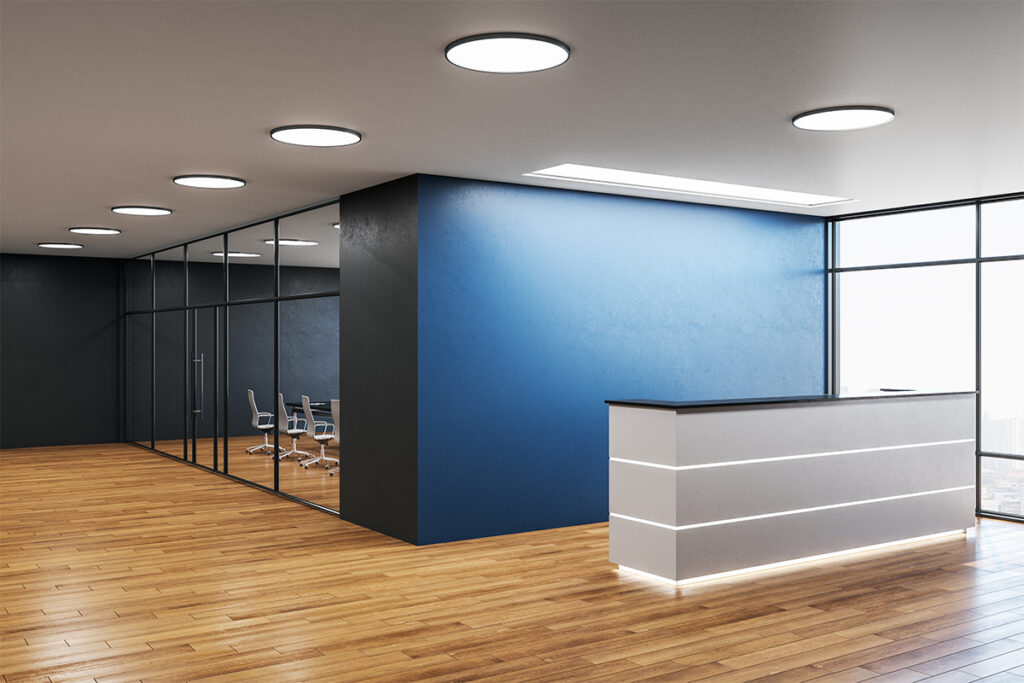
General lighting serves as the primary illumination source within a space. This uniform, base level of lighting is often the focal point for energy reduction efforts, particularly when employing LED sources.
The recommended light levels for general lighting are 30 to 50 footcandles. This illumination should provide overall visibility, facilitate general tasks, and manage contrast ratios. Diffused general lighting fosters a sense of well-being, ensuring employees feel comfortable. This can be achieved by arranging recessed fixtures with reflectors, baffles, and lensed trims in overlapping configurations.
Perimeter lighting, or wall washing, further defines spaces, offers vertical lighting, and imparts a sense of spaciousness. Sconces or wall washers can create a welcoming environment. Illuminating vertical surfaces enhances visual comfort, spatial definition, and directional cues, making spaces appear larger, open, and more inviting.
Task Lighting
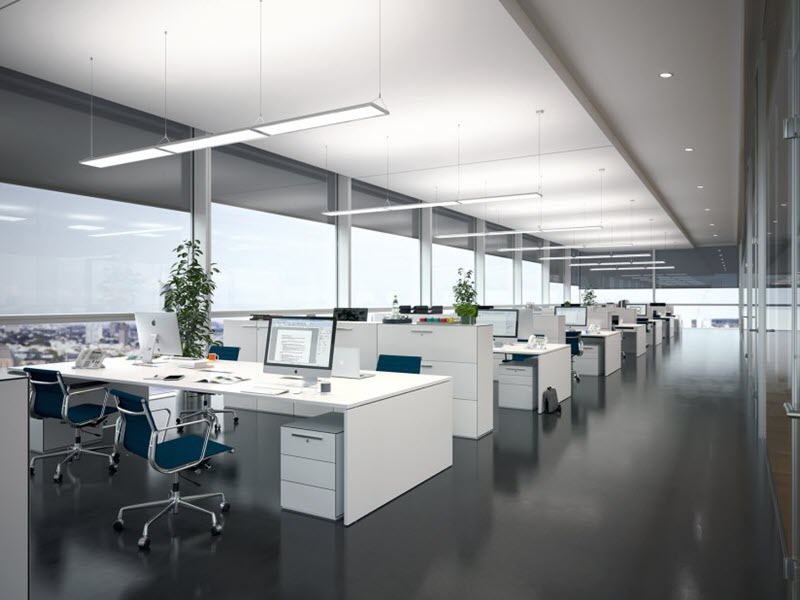
Task lighting illuminates specific areas for particular tasks, providing focused, localized, and higher levels of illumination. Essential for the functionality of a space, it is important to utilize energy-efficient sources to minimize operating costs.
Task lighting complements general lighting in workspaces, conference areas, and countertops. Effective task lighting should eliminate shadows and prevent glare from the lamp or reflective surfaces. Glare, which impedes office work, can be controlled by adjusting the brightness of surrounding areas or the glare source.
Recommended light levels for task areas are 50 to 200 footcandles. Consider the contrast between the task area and the surrounding space, with a 3:1 ratio of task lighting to general illumination providing a suitable contrast. Adjusting the luminance in task areas can compensate for low contrast levels. For office spaces, a combination of low-level ambient light with strategically placed task luminaires is ideal, conserving energy and enhancing lighting quality.
Accent Lighting
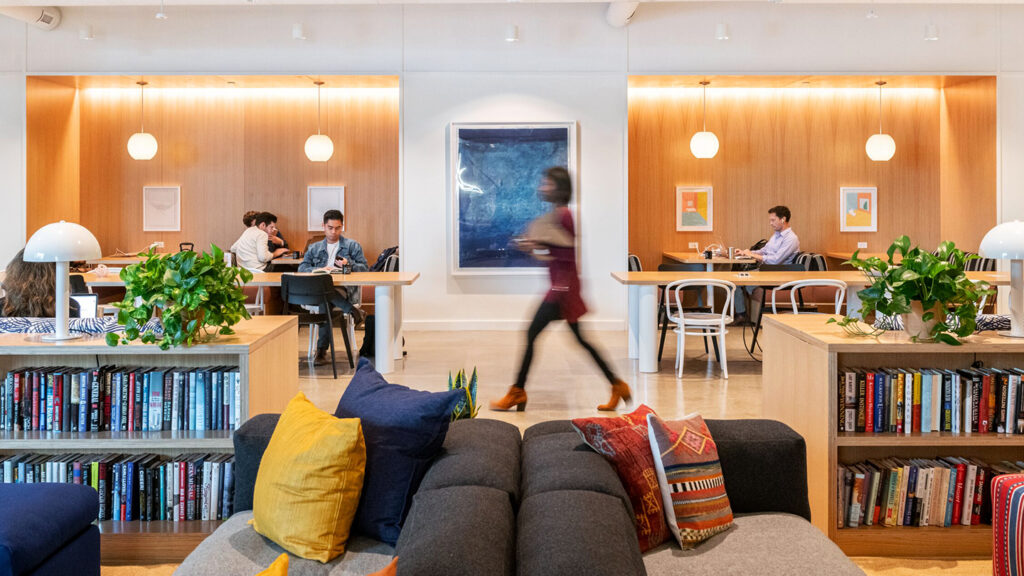
Accent lighting enhances design aesthetics by emphasizing shapes, textures, finishes, and colors through focused light sources. Precision and higher intensity compared to ambient light are key to effective accent lighting, avoiding unwanted shadows and distracting glare.
Track fixtures, recessed housings with adjustable trims, and concealed adjustable illumination with point source lamps offer directional control, effectively highlighting objects’ best attributes. A common mistake is over-illuminating, which diminishes the impact of accent lighting.
The IESNA recommends a 5:1 ratio of accent lighting to ambient light to create a significant visual effect. Recommended light levels for accent lighting range from 150 to 500 footcandles.
Decorative Lighting
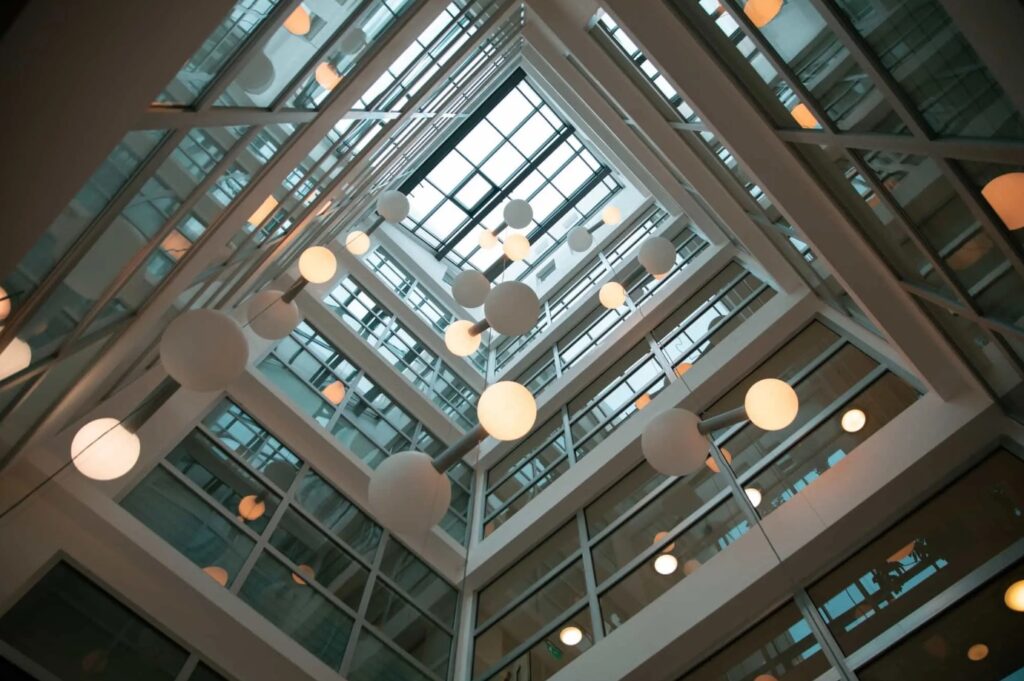
Decorative lighting serves a dual purpose: contributing to the overall lighting scheme and enhancing the space as a design element. This category includes pendants, sconces, chandeliers, table and floor lamps, and cylinders. Decorative lighting should complement the interior design and add visual interest, while also fulfilling functional lighting needs.
Pendants should be mounted 8 to 12 feet above the finished floor (a.f.f.), ensuring visibility without causing distraction. Over desks and counters, pendants should be hung 36 to 48 inches above the horizontal plane, providing task and/or accent lighting while adding sparkle.
Wall sconces and wall-mounted cylinders should be positioned approximately 5.5 feet a.f.f. to establish a sense of human scale, particularly in large spaces. Decorative lighting also reflects a company’s image and reinforces the space’s theme and style, contributing to a sense of hospitality and comfort.
Ambient Lighting
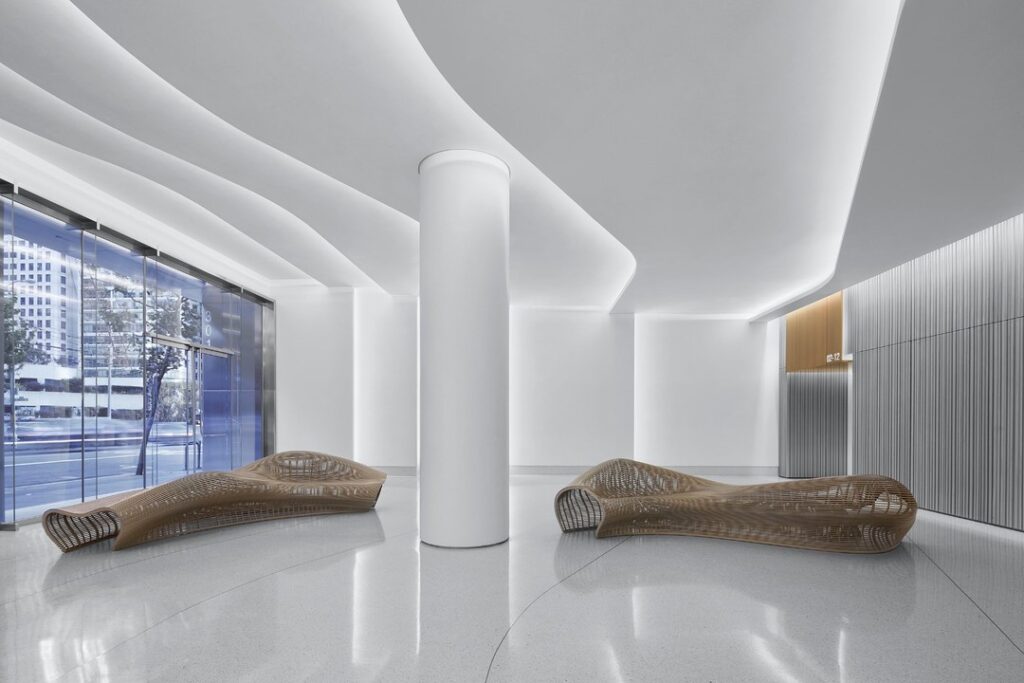
Ambient lighting, also known as mood lighting, subtly enhances the overall atmosphere of a space. This layer creates a soft, diffuse light that fills the room, reducing harsh shadows and providing a sense of warmth and comfort. Ambient lighting can be achieved using dimmable fixtures, indirect lighting, or soft white lampshades.
Recommended light levels for ambient lighting are typically lower, around 10 to 30 footcandles, as the goal is to complement other lighting layers without overpowering them. By carefully balancing ambient lighting with other sources, a harmonious and inviting environment is created.
Natural Lighting
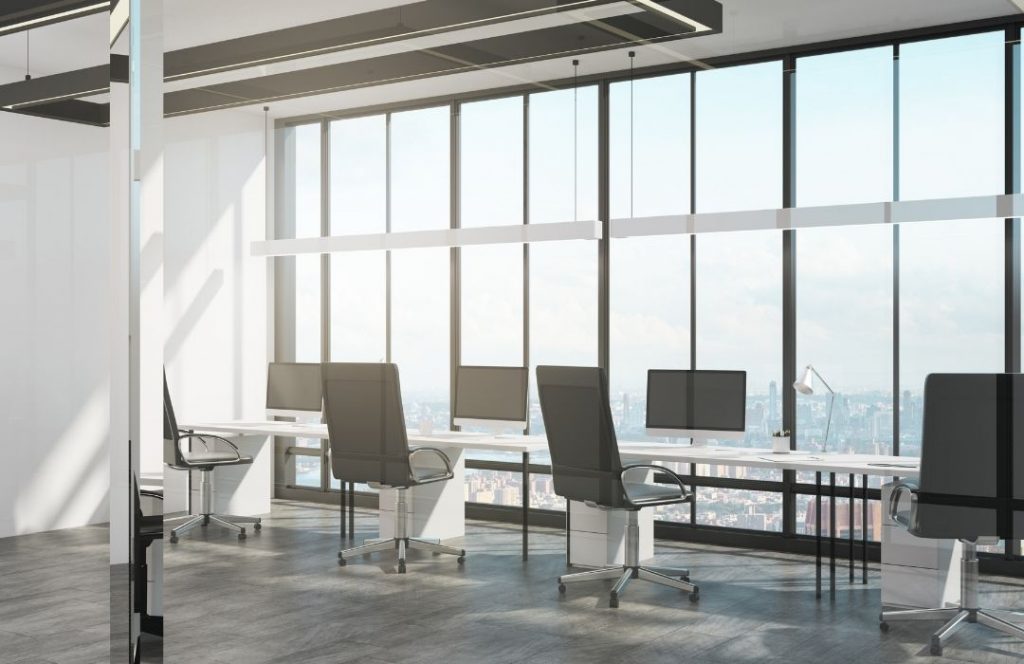
Natural lighting harnesses daylight to illuminate interiors, enhancing both energy efficiency and the well-being of occupants. Incorporating windows, skylights, and light shelves allows natural light to penetrate deep into spaces, reducing the reliance on artificial lighting.
Effective use of natural light requires consideration of building orientation, window placement, and the use of reflective surfaces to maximize daylight distribution. Natural lighting not only conserves energy but also supports circadian rhythms, improving mood and productivity.
By skillfully combining and layering these six types of lighting, the environment becomes more attractive, dynamic, and inviting.
Application Solutions
Sustainable Lighting Design
The International Association of Lighting Designers (IALD) defines sustainable lighting design as fulfilling the qualitative needs of the visual environment while minimizing the impact on the physical environment. Achieving this balance between visual requirements and product sustainability is paramount.
7 Goals of Energy Smart Design:
- Illuminate the Space Appropriately: Consider both architectural elements and human interaction within the space to ensure proper illumination.
- Integrate Layers of Light: Maximize illumination where it is needed by layering different types of lighting.
- Use Efficient Technology: Employ the most efficient lamp and ballast technology suitable for the space.
- Implement Appropriate Controls: Utilize controls for light level and energy management to optimize efficiency.
- Integrate Daylight: Leverage natural light to reduce reliance on artificial sources and enhance the ambiance.
- Prioritize Longevity and Durability: Select lighting solutions that offer long lifespans and require minimal maintenance, thus reducing waste and operational costs.
- Enhance Visual Comfort and Well-being: Ensure that lighting contributes to the comfort and health of occupants by reducing glare and creating a pleasant atmosphere.
Considerations for Commercial Lighting

- Size and Shape of the Space: The dimensions and configuration of the area are critical in crafting an effective lighting plan. These factors dictate the type and placement of luminaires to ensure uniform illumination.
- Traffic Patterns Through the Space: Understanding how people navigate the space is essential. Lighting should facilitate safe and efficient movement, highlighting pathways and key areas.
- Purpose of Each Room: Each room’s function determines its lighting requirements. Spaces for specific tasks may need higher illumination levels compared to areas meant for relaxation or general use.
- Ceiling Height and Shape: The height and contour of the ceiling influence how light is distributed and reflected. Higher ceilings may require more powerful lighting or additional fixtures to achieve the desired ambient light levels.
- Wall Color: The color of the walls significantly impacts lighting design. Darker hues absorb more light, necessitating higher illumination to achieve the same brightness as lighter-colored walls. A brightly lit office not only improves visibility but also enhances the corporate image.
- Art and Highlight Areas: Identifying focal points such as artwork or architectural features helps in planning accent lighting. This ensures these elements receive appropriate emphasis, enhancing the aesthetic appeal of the space.
- Families of Luminaires: Consistency in the design and finish of luminaires is vital. Recessed downlights, adjustable accents, and wall washers should match in aperture sizes and trim finishes, using similar lamp types. Harmonizing these with the overall fixture design avoids undue attention to the lighting system itself, ensuring a cohesive and professional look.
- Energy Efficiency: Incorporating energy-efficient lighting solutions is essential for reducing operational costs and promoting sustainability. Utilize LED fixtures and automated lighting controls, such as occupancy sensors and dimmers, to optimize energy consumption without compromising illumination quality.
- Integration with Natural Light: Maximizing the use of natural light not only conserves energy but also enhances the well-being of occupants. Strategic placement of windows, skylights, and light shelves can harness daylight, reducing the need for artificial lighting and creating a more pleasant and healthful environment.
- Maintenance and Accessibility: Consideration of maintenance requirements and ease of access to lighting fixtures is crucial. Opt for fixtures that are durable and easy to maintain, ensuring that routine maintenance can be performed with minimal disruption to the workspace.
Effective lighting should be seamlessly integrated into the architecture, enhancing the design, reinforcing activities, and highlighting key areas. A “one size fits all” approach is ineffective; different areas have unique lighting needs. It is crucial to design on a space-by-space basis to determine specific lighting criteria while allowing for personalization. Simplifying the lighting design prevents visual clutter; using a family of luminaires ensures cohesiveness. Layering ambient, task, and accent lighting achieves an optimal balance.
Lighting constitutes about 30% of office electricity usage. Dimming controls can reduce energy costs by adjusting light levels to conserve energy, extend lamp life, and tailor illumination intensity to specific tasks and activities. Many LEDAPLUS Lighting products are compatible with dimming controls.
Reception Area
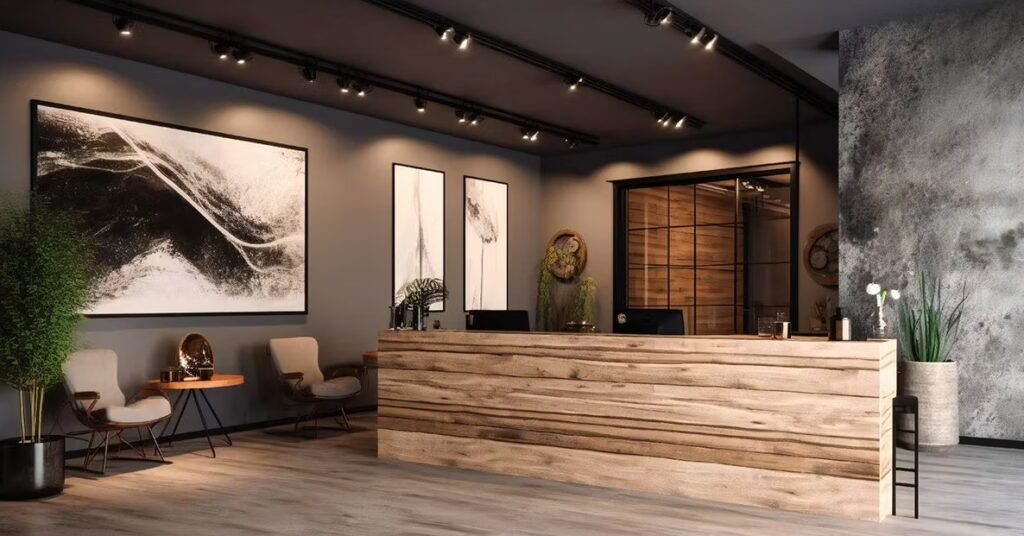
The reception area forms visitors’ first impression. Lighting must complement architecture, facilitate a safe transition from exterior to interior, and convey a strong corporate image. This area typically requires distinct lighting for the receptionist and waiting visitors. The receptionist’s face should be well-lit for approachability, while the waiting area should be restful yet sufficiently illuminated for simple tasks.
Corridors
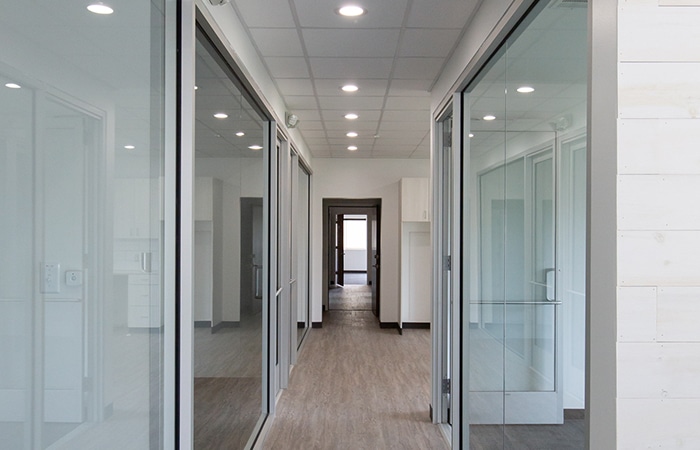
Corridors must remain illuminated for extended periods, often continuously. To conserve energy, provide at least one-fifth the illuminance level of adjacent areas, ensuring safe navigation without affecting eye adaptation. Lighting walls and ceilings makes corridors feel larger and more open. Emergency lighting is essential as corridors serve as egress paths.
Conference Rooms
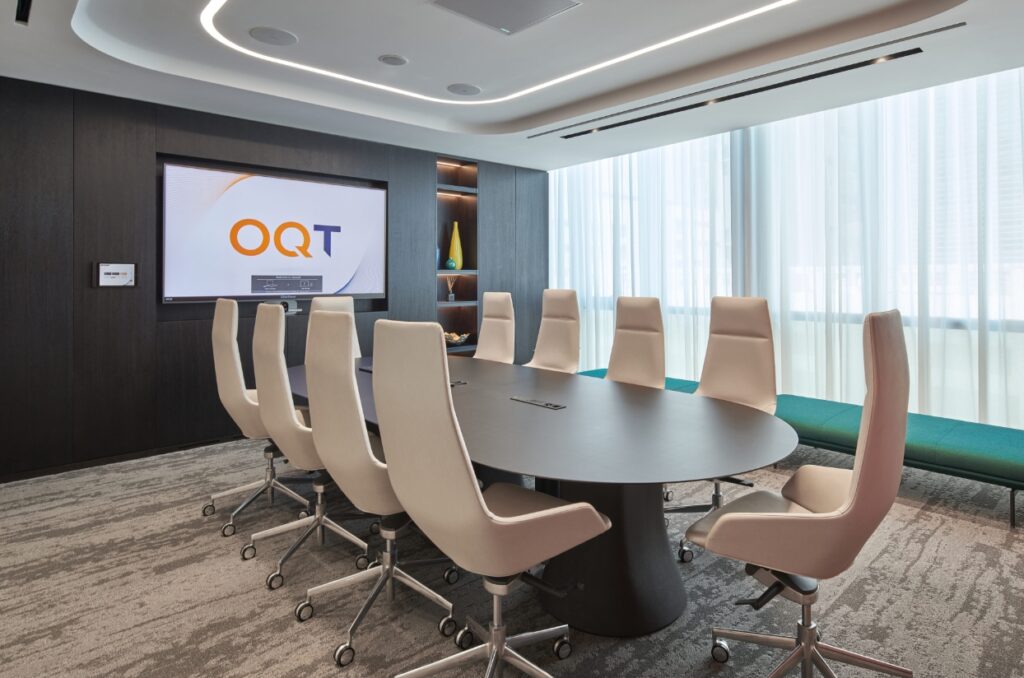
Conference rooms accommodate varied functions, from presentations to brainstorming sessions. Lighting must offer flexibility and visual comfort. General lighting should be dimmable for presentations, with appropriate task lighting for reading and writing, and sufficient illumination on seated individuals.
Open Plan Office Space
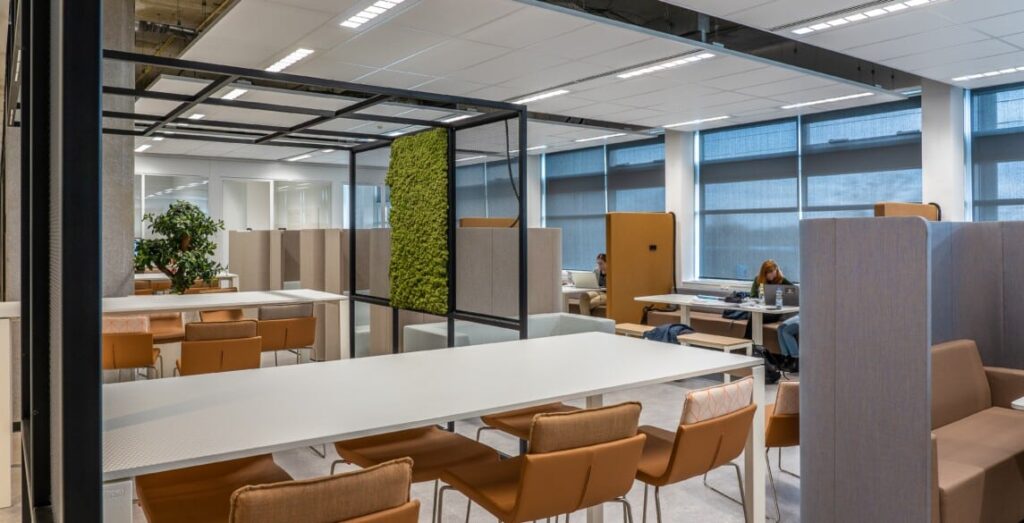
Open plan offices host diverse tasks. Ambient lighting should be comfortable and functional, consistent with the overall lighting plan. Furniture impacts light distribution and general luminance. Task lighting should provide higher illumination levels at specific locations, distributed uniformly to avoid hot spots and glare, which cause eye strain and headaches. Flexibility is crucial as workstations are often transient.
Private Office Space
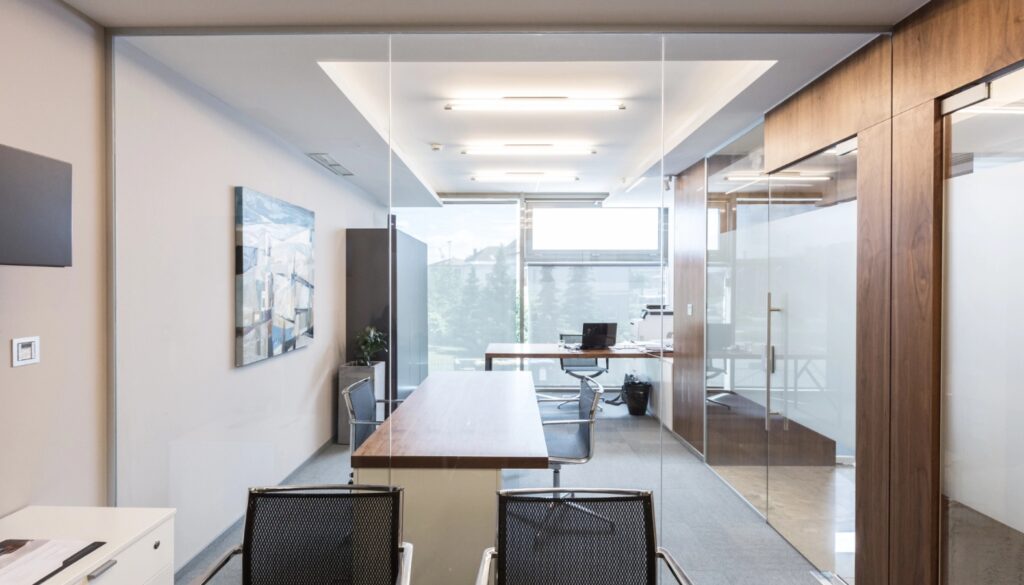
Private offices serve individual and group activities. Ambient lighting should support navigation and conversation, with adequate task lighting over work surfaces. Accent lighting adds variety and interest, highlighting artwork or materials with adjustable recessed housings or track heads. Luminaire design should complement the architectural and interior style.
Exit & Emergency Lighting
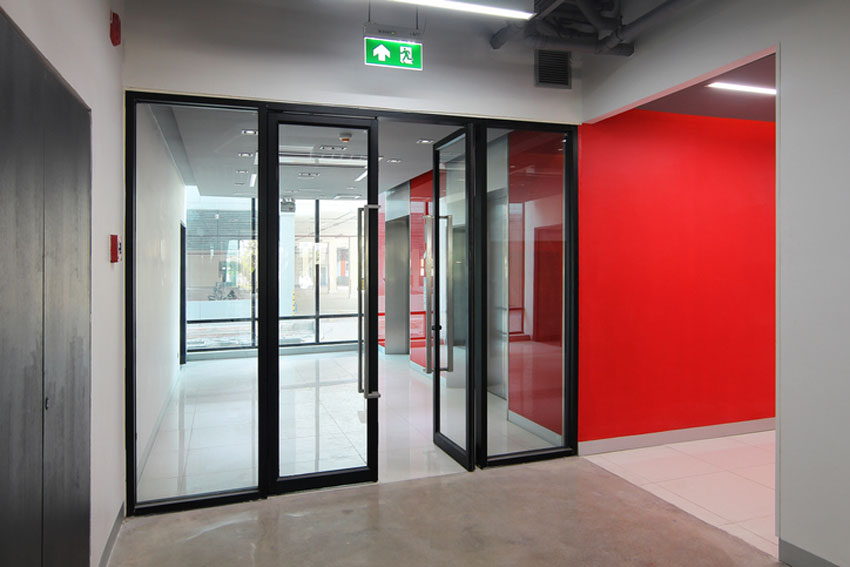
LEDAPLUS offers high-quality exit and emergency lighting fixtures. When general lighting systems fail, these fixtures guide safe exits or provide security and comfort until restoration. LEDAPLUS’s fixtures meet or exceed NFPA101, NEC, and UL294 standards.
Conclusion
Office lighting design is a pivotal element that goes beyond mere functionality—it shapes the atmosphere, enhances productivity, and influences the well-being of employees. LEDAPLUS is committed to crafting bespoke lighting solutions that integrate seamlessly with your office’s interior design, leveraging cutting-edge technology and sustainable practices to create vibrant, efficient, and inviting workspaces. By partnering with LEDAPLUS, you ensure that your lighting investment not only meets but exceeds expectations, fostering a workplace environment where both business objectives and employee satisfaction thrive.
FAQ
Illuminance Categories and Illuminance Values for Generic Types of Activities in Interiors
| Type of Activity | Illuminance Category | Footcandles | Reference Work-Plane |
| Public spaces with dark surroundings | A | 2-3-5 | General lighting through spaces |
| Simple orientation for short temporary visits | B | 5-7.5-10 | |
| Working spaces where visual tasks are only occasionally performed | C | 10-15-20 | |
| Performance of visual tasks of high contrast or large size | D | 20-30-50 | Illuminance on task |
| Performance of visual tasks of medium con- Illuminance on task trust or small size | E | 50-75-100 | |
| Performance or visual tasks of low contrast or very small size | F | 100-150-200 | |
| Performance of visual tasks of low contrast and very small size over a prolonged period | G | 200-300-500 | Illuminance on task, obtained by a combination of general and local (supplemental lighting) |
| Performance of a very prolonged and exacting visual task | H | 500-750-1000 | |
| Performance of very special visual tasks of extremely low contrast and small size | I | 1000-1500-2000 |
Weighting Factors to Be Considered in Selecting Specific Illimninance Levels
| For Illuminance Categories A through C | |||
| Room and Occupant Characteristics | Weighting factor | ||
| -1 | 0 | +1 | |
| Occupant Ages | Under 40 | 40-55 | Over 55 |
| Room Surface Reflectances | Greater than 70% | 30-70% | Less than 30% |
| For Illuminance Categories D through I | |||
| Task and Worker Characteristics | Weighting factor | ||
| -1 | 0 | +1 | |
| Worker’s Ages | Under 40 | 40-55 | Over 55 |
| Speed and/or Accuracy | Not Important | Important | Critical |
| Reflectance of Task Background | Greater than 70% | 30-70% | Less than 30% |
Commercial Illuminance recommendations for General Lighting and Specifice Visual Tasks
| Areas/Activity | Illuminance Category | |
| Horizontal | Vertical | |
| Conference Rooms | ||
| Meeting | D | B |
| Video Conference | E | D |
| Offices | ||
| Filing | E | C |
| Open Office, Heavy Computer Use | D | B |
| Open Office, Intermittent Computer Use | E | B |
| Private Office | E | B |
| Mail Sorting | E | A |
| Copy Rooms | C | A |
| Lobbies, Lounges, and Reception Areas | C | A |
| Service Spaces | ||
| Stairways and Corridors | B | |
| Elevators, Passenger | B | A |
| Toilets and Washrooms | B | A |
